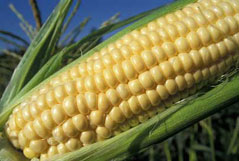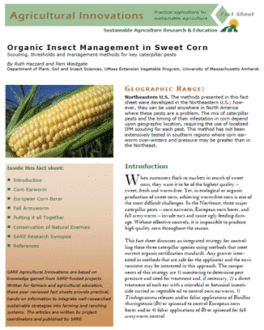
Oils:
Corn and Soybean Oils. Vegetable oil alone reduces the amount of caterpillar feeding damage in the tips of corn ears; however, it is most effective when used as a carrier for Bt [4]. The oil coats the silk channel and reaches the ear tip, increasing the effectiveness of the Bt. Water is not a good carrier because it beads up on the silk and does not fill the space within the channel. Both corn and soybean oils conform to all of the regulations listed above. It requires about 2.1 gallons of oil to treat one acre, applied at 0.5 ml per ear of corn (estimating 16,000 ears/acre). Corn or soy oil may be available in certain formulations as a registered pesticide (see emulsifier/oil combos, below), or may be purchased in food grade form from grocery stores. Before using corn or soy oil check with your state agency in charge of pesticides to determine any legal restrictions on its use in your state.
Petroleum-based oils. Highly refined petroleum oils, also known as narrow range mineral oils, have been shown to be effective as an oil carrier, but they have not been tested as extensively because their organic status has been inconsistent over the years. These oils must meet the regulatory requirements described at the beginning of this section.
Emulsifiers: If you are using a dry insecticide formulation it is recommended that you use an emulsifier to insure a stable suspension in the oil.
Lecithin. Add 5% volume of liquid lecithin to the oil before adding the dry material mixed in water (e.g. add 5 ml lecithin to 95 ml oil). Liquid lecithin is the consistency of molasses; we strongly recommend that you add it directly to the oil instead of measuring into a separate container first. Lecithin will mix readily with oil but will not mix directly with water, making cleanup difficult.
Liquid Bt’s with emulsifiers. If you are NOT certified organic you may be able to use a liquid Bt product and avoid the need for an added emulsifier. Liquid Bt products allowed for organic production may become available in the future. Check with OMRI for updates.
Oil/Emulsifier combinations: Although more expensive than buying them separately, some organic crop oils come with an emulsifier already mixed into them, and are labeled for caterpillar control in corn. These can be either vegetable-based or narrow range mineral oils. If you are organically certified use a product that has been reviewed by OMRI and is allowed in organic production (www.omri.org). Before applying any of these products, make sure that the product is labeled for use on corn and is registered in your state.
Carrageenan as an alternative carrier: The need for an emulsifier can be avoided with the use of carrageenan instead of oil. Carrageenan, derived from seaweed and exempt from FIFRA and food tolerance, can be used as an alternative carrier. Since it is water based, dry formulations of insecticides will mix readily, eliminating the need for an emulsifier; however, because of the water base, it does not penetrate the silk channel like oil and must be injected well into the silk channel. Also, on its own carrageenan has little effectiveness against corn earworm, acting primarily as a carrier of the toxins. Further work is needed to evaluate carrageenan as part of this method, but it does appear to reduce or eliminate the cone-tip effect.
Other factors
Sweet corn cultivars: Good husk coverage at the tip of the ear enhances the effectiveness of this technique. This is especially important where corn earworm pressure is extremely high. Look for cultivars that suit your climate and your market and also have a tight husk with a long extension above the ear throughout maturity. A tight husk protects the ears by holding the oil in a narrow channel, forcing caterpillars to encounter the oil and Bt to reach the ear. Another trait that contributes to success with the oil method is consistent plant development and ear maturity.
Available sweet corn varieties change rapidly. Variety trials conducted in Maine in 1999, 2000, and 2001 [6] and in Maryland in 2003 [7] have identified some varieties that have good husk coverage. Of the varieties tested in Maine, Sweet Chorus, Sweet Symphony, Wizard (variable maturity), Bon Appetite, Delectable, Providence, Serendipity, Twilight, and War Dance (all se), and Jumpstart and SS#6082 BC (sh2) all had good tip coverage. Of those tested in Maryland, Temptation, Argent, and Frosty (se) and Punchline (sh2) had good tip coverage and a tight husk.
Weed control: Since this method involves walking through a cornfield and treating every corn ear, it is important that you have good weed control in your corn field. Tall weeds at the time of application interfere with access to each ear, thereby reducing the effectiveness of the control method.
Weather: One advantage of this method is that oil can be applied in windy or even wet weather. If it rains after the oil application, it is not necessary to re-apply the oil. We have found that the oil method works best in healthy, well-nourished, actively growing, sweet corn. Long periods of cold, wet weather or periods of drought that cause plant and ear growth to slow sometimes result in poor control or may increase the cone tip effect.
